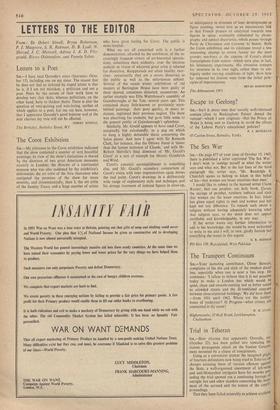The 'Corot Exhibition
SIR,—My reference to the Corot exhibition indicated that the show contained a number of very beautiful paintings; its view of the show's limitations is shared by the directors of two great American museums recently in London; the director of a continental museum who was also saddened by the exhibition's deficiencies; the art critic of the New Statesman who castigated the premises of the show far more severely, and circumstantially, than I; the art critic of the Sunday Times, and a large number of artists who have great feeling for Corot. The public is more trustful.
What we are all concerned with is a further demonstration, afforded by the exhibition, of the in- creasingly frequent victory of art-historical specula- tions, sometimes mere pedantry, over the intrinsic testhetic or vision of whatever great artist is selected for dissection. Reappraisals are often healthy exer- cises: occasionally they are a severe disservice to the public as well as the unfortunate subject. Several of the recent winter exhibitions of old masters at Burlington House have been guilty of these slanted, sometimes distorted, manoeuvres. An earlier example was Ellis Waterhouse's assembly of Gainsboroughs at the Tate, several years ago. This contained many little-known or previously unex- hibited paintings: their poor quality, in many in- stances, explained their previous neglect. The Show was absorbing for students, but gave little sense to the general public of Gainsborough's splendour.
Similarly, Mr. Gould appears to have used Corot, marginally but calculatedly, as a peg on which to hang a highly debatable thesis concerning the Salon pieces. And here I agree with Sir Kenneth Clark, for instance, that the Ottawa Narni is 'tamer than the tamest imitation of Claude,' and with Mr. Robert Melville's final dismissal of 'Mr. Gould's Corot' as a sort of triumph for Messrs. Gombrich and Wind.
Corot's essential, accomplishment is something else, and Mr. Gould's secondary comparison of Corot's vision with later impressionism again misses the real point. Corot's drawings in a deliberately wide range of exploratory style and technique and his strange treatment of isolated figures in close-up,. so anticipatory in structure of later developments in figure painting. reveal him as an unconscious link in that French process of analytical research into figures in space. eventually stimulated by photo- graphy and optical discoveries, which passes through Puvis de Chavannes and Uzanne to Seurat Both the Corot exhibition and its catalogue reveal a less interesting attempt to revive, favour for the inert grandes machines at the expense of Corot's direct transcriptions from nature--which were also. in fact, his laboratory experiments. His obsessive concern for structure in its own right, rather than its am- biguity under varying conditions of light, show how far removed his interest were from the initial prin- ciples of impressionism.
The Athenaeum, SW I
BRYAN ROBERTSON






































 Previous page
Previous page